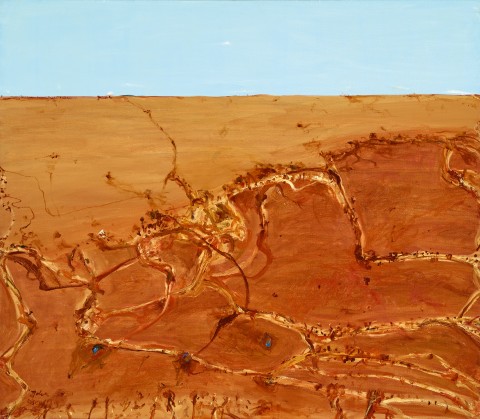DRY RIVERBEDS, 2005
JOHN OLSEN
oil on canvas
106.0 x 122.0 cm
signed and dated lower left: John / Olsen / ’05
signed and inscribed with title verso: “DRY RIVERBEDS” / JOHN OLSEN
Tim Olsen Gallery, Sydney
Private collection, Sydney, acquired from the above in October 2005
John Olsen, The Flight to Broome, Tim Olsen Gallery, Sydney, 15 October – 19 November 2005, cat. 8 (illus., front cover, n.p.)
With a vast and varied oeuvre spanning more than seven decades, John Olsen has quite deservedly been hailed Australia’s greatest living artist. From the pulsating, larrikin energy of his You Beaut Country series, to the quieter, more metaphysical paintings inspired by his expeditions to Lake Eyre, or the exquisitely lyrical works immortalising his halcyon days in Clarendon, Olsen’s unique interpretations of the natural environment in its manifold moods have become indelibly etched on the national psyche, revolutionising the way in which we now perceive the Australian landscape. Indeed, where artistic predecessors such as Russell Drysdale and Sidney Nolan had presented visions of a parched, inhospitable land where figures stand as sentinels in the wilderness, Olsen instead highlights the teeming activity and incident within this remote region, inviting the viewer to experience his sheer wonderment at the redemptive, life-affirming properties of mother nature: ‘The urge for life is a staggering thing and we just ought to take notice … There is such fecundity in this universe’.1
Painted in 2005, Dry Riverbeds encapsulates Olsen’s remarkable ability to capture both the immensity and intricacy of the Australian landscape. Employing his signature ‘all-at-once’, multi-perspective approach – ‘I’m down on the canvas one moment and up flying the next, or looking sideways or underneath’2 – thus the work possesses a remarkable breadth and spaciousness which conveys tangibly the sight as well as the feel of this sparse terrain. Map-like, the aerial view details the solid but sinuous form of the parched riverbed meandering through the folds of the surrounding ochre gorges and plains – here evoked through an irreverent tangle of squiggling lines and pattern. As the eye ascends upwards through the picture plane, it is brought back to reality by the illusion of depth suggested in the conventional horizon line and flat field of blue sky beyond. Even within this expansive scene however, importantly Olsen still incorporates delightful details of local wildlife – encouraging the viewer to appreciate the relationship between the tiny and the vast, the microcosm and macrocosm in a manner reminiscent of his first responses to the area three decades earlier (when travelling to Lake Eyre in 1974). Witnessing first-hand the arid, salt-encrusted plains of the South Australian desert erupting into a veritable oasis, ‘a carnival of life’ following the extraordinary floods of 1973 (only the second such occurrence since white settlement), Olsen had been immediately awestruck by discovery of the monumental in the miniature: ‘My devotion to Chinese art and philosophy finds fulfilment in this experience. Nothing too small or too strange should escape my attention – an insect’s wing, the leap of a frog, the flight pattern of dragonflies. They all induce poetic rapture’.3
Far from being a despondent image of the wild, desolate reaches of the country’s dry interior, the present work resonates with a vitalistic energy – betraying a sense of not only keen observation, but joyful celebration derived from a lifetime dedicated to physical and spiritual immersion in the landscape. For ultimately, as Olsen poignantly muses, the Australian outback offered more than mere topographical phenomena to be accurately recorded. More fundamentally perhaps, the experience was the catalyst for a myriad of ideas and metaphorical connections that reaffirmed his Taoist belief in the total interconnectedness of all living forms, thereby heralding a new spirituality in his art:
'The enigma of it all. It is a desert and it can be full. After the rains, it is so incredibly abundant; so what you are looking at in one place, as if through an act of the Dao, becomes full … It has an effect on you when you are there because all the time it is impossible for you to accept fully the sense of impermanence and transitoriness. Somehow it affects you – you realise that you are looking at an illusion really. I don't think that there is anything more Buddhist than that’.4
1. Olsen quoted in Hart, D., John Olsen, Craftsman House, Sydney, 1991, p. 123
2. Olsen quoted in Hawley, J., 'John Olsen', Encounters with Australian Artists, University of Queensland Press, Queensland, 1993, p. 129
3. Olsen quoted in Olsen, J., Drawn from Life, Duffy and Snellgrove, Sydney, 1997, p. 116
4. Olsen quoted in Hart, op. cit., p.135
VERONICA ANGELATOS
